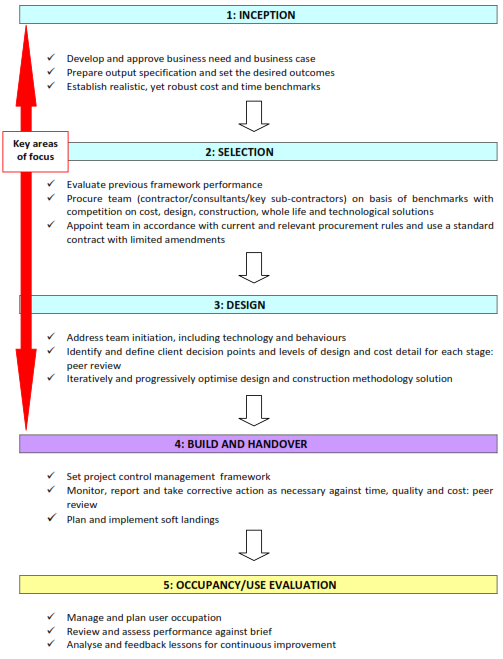Cost led procurement
Contents |
[edit] Introduction
The main aims of the Government Construction Strategy were to ‘change the relationship between Clients and Industry’ and achieve a 15-20% reduction in public sector construction costs by 2015. The Government Construction Task Group report 2012 developed three potential new strategies to help achieve these aims:
- Cost Led Procurement (CLP).
- Integrated Project Insurance (IPI).
- Two Stage Open Book.
All three involve early contractor involvement, transparency and integration. Along with a reduction in costs, they are expected to contribute to a reduction in project risk, improved programme accuracy and an enhanced working relationship between client and the supply chain.
[edit] Background
The Cost Led Procurement method is ‘...intended to allow industry to use its experience and knowledge to develop innovative solutions through leveraging design, materials, subcontracting, direct labour and experience to the advantage of the Public Sector Client...focused on achieving target costs whilst maintaining, if not improving value’ (Cabinet Office, 2014).
In Cost Led Procurement, the project details are clearly identified and a ceiling cost calculated. Typically, an integrated supply team (one or more) is identified through a framework agreement and the team work together to complete the project at below the ceiling cost. In subsequent similar projects within a framework, Cost Led Procurement offers the opportunity for further reduction of costs.
The project is offered to suppliers outside the framework if none of the existing teams are able to deliver the project below the ceiling cost.
[edit] Structure
The CLP plan involves five phases:
- Inception.
- Selection of contractor.
- Design and cost development.
- Construction.
- Operation
The flow chart from the 2014 Cabinet Office publication, Cost Led Procurement Guidance outlines the process.
[edit] Trial projects
Two trial projects were run using the CLP method: Upper Mole and Rye Harbour. The Rye Harbour scheme was successful in achieving a 6% saving through reducing the project programme.
This article contains public sector information licensed under the Open Government Licence v2.0 ref Cabinet Office, Cost Led Procurement Guidance 2014.
[edit] Related articles on Designing Buildings Wiki
- Framework agreement.
- Government construction strategy.
- Integrated project insurance.
- Integrated supply team.
- Managing the procurement process.
- Optimised contractor involvement.
- Procurement route.
- Supply chain.
- Supply chain management.
- Sustainable procurement.
- The benefits of e-procurement in construction.
- Two stage open book.
- Value for money.
[edit] External references
Featured articles and news
Amendment to the GB Energy Bill welcomed by ECA
Move prevents nationally-owned energy company from investing in solar panels produced by modern slavery.
Gregor Harvie argues that AI is state-sanctioned theft of IP.
Heat pumps, vehicle chargers and heating appliances must be sold with smart functionality.
Experimental AI housing target help for councils
Experimental AI could help councils meet housing targets by digitising records.
New-style degrees set for reformed ARB accreditation
Following the ARB Tomorrow's Architects competency outcomes for Architects.
BSRIA Occupant Wellbeing survey BOW
Occupant satisfaction and wellbeing tool inc. physical environment, indoor facilities, functionality and accessibility.
Preserving, waterproofing and decorating buildings.
Many resources for visitors aswell as new features for members.
Using technology to empower communities
The Community data platform; capturing the DNA of a place and fostering participation, for better design.
Heat pump and wind turbine sound calculations for PDRs
MCS publish updated sound calculation standards for permitted development installations.
Homes England creates largest housing-led site in the North
Successful, 34 hectare land acquisition with the residential allocation now completed.
Scottish apprenticeship training proposals
General support although better accountability and transparency is sought.
The history of building regulations
A story of belated action in response to crisis.
Moisture, fire safety and emerging trends in living walls
How wet is your wall?
Current policy explained and newly published consultation by the UK and Welsh Governments.
British architecture 1919–39. Book review.
Conservation of listed prefabs in Moseley.
Energy industry calls for urgent reform.

























